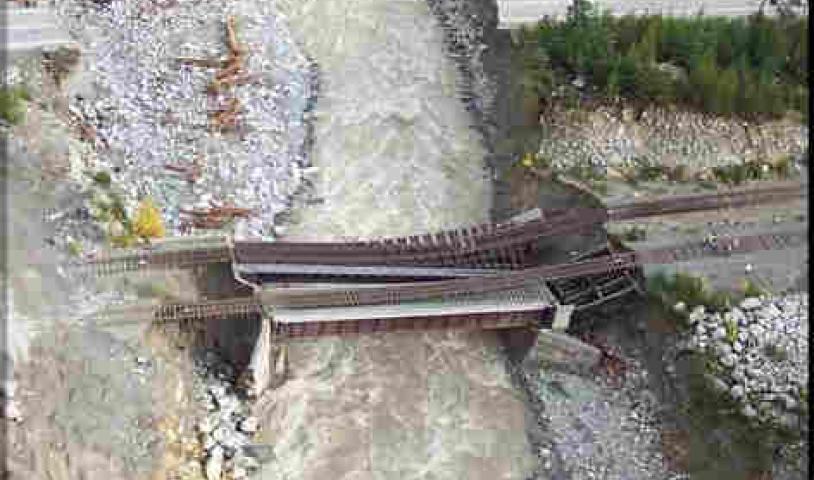Rutherford documents raise questions: WCWC
Thursday, April 22, 2010
Kiewit official, though, says construction deficiencies played no role in ’03 bridge washout
Recently uncovered documents surrounding the building of the Rutherford Creek power plant raise new questions about whether deficiencies in its construction contributed to the 2003 washout of the Highway 99 bridge crossing the creek, an official with the B.C.-based Western Canada Wilderness Committee (WCWC) said this week.
However, an official with the company that built the plant countered that in the months after the Oct. 18, 2003 washout, which resulted in the deaths of five people whose vehicles plunged into the raging creek, officials found no connection between the upstream plant construction activity and the bridge collapse.
In 2005, Peter Kiewit Sons was fined $5,000 for breaching forest road regulations in five places on the road leading upstream from the bridge, according to documents obtained in a WCWC freedom of information request.
According to documents, the contractor failed to install the required drainage ditches and culverts upstream from the bridge. What’s more, Ministry of Forests officials shut down construction on the site because of numerous contraventions of the Forest Practices Code on Oct. 17, 2003 — just hours before the bridge washed out.
Gwen Barlee, WCWC policy director, on Tuesday (April 20) said she thinks the documents raise questions about what role the deficiencies might have played in the washout.
“The Rutherford Creek Bridge blowout happened about 12 hours after the Ministry of Forests shut down the project due to deficiencies,” Barlee said. “It’s not to say — and we’re careful to point this out — that the problems with the power plant construction played a role in the bridge blowout.
“What it does do, though, is it raises some serious questions.”
Kent Grisham, a spokesman for Peter Kiewit and Sons’ North American operations, on Tuesday expressed sympathy and support for the families of those who died and said he doesn’t know why WCWC is raising the issue now.
“The washout cannot be connected in any way to the construction project, and that question was examined after the fact and it was determined that the project didn’t play any role at all in the washout,” Grishman said on Tuesday.
“We applaud those people who are so interested and dedicated to protecting the environment, but I really question why they’re bringing up this question when it was so thorougly examined seven years ago when it brings back so many painful questions for the families that lost someone. It’s just really unnecessary.
“Let’s not stir up people’s grief unnecessarily, and this really is an unnecessary endeavour.”
A Ministry of Forests spokesperson also told The Province newspaper this week that the maintenance infractions did not contribute to the bridge collapse.
Barlee, though, said the general public is unaware of the size and scale of the disruption caused during the construction phase of most run-of-river projects. The plans for Rutherford Creek, for example, called for Kiewit crews to excavate some 600,000 tonnes of soil in the construction of the road and penstock for the project, The Province reported.
Given the fact that provincial government officials shut the project down and fined the company because of the lack of proper drainage, “People have to put their thinking caps on and say ‘At the very best, this looks bad,’” Barlee said. “People —especially the families of those who died — have a right to ask questions and have them answered so that they can understand what actually happened.”
Barlee said that while the tragic loss of five lives as a result of the bridge washout is important, the picture of run-of-river project construction painted by the documents is one that should concern all British Columbians, especially with hundreds more either under construction or in the planning stages.
Barlee said that in addition to proper oversight on individual projects, citizens should demand that there’s cumulative planning when dozens are planned or under construction in a given area, such as the Sea to Sky.
“What this shows is that it’s a gold rush out there and there aren’t adequate protections place to be sure that the highest environmental standards are being met,” she said. “This is just another instance that shows that they’re not.”
Two lawsuits filed in relation to the death of Jamie Burnette, one of the five men who died as a result of the bridge washout, appear to have been resolved.
One case, brought by Jamie’s wife Kathleen (Katie) Burnette against the B.C. Minister of Public Safety and Solicitor General on behalf of their son Cole, was resolved by way of an out-of-court settlement on April 4, 2008, court records show.
A notice of discontinuance was filed on March 22, 2006, in a case brought by Katie Burnette against the Province of B.C., Resort Municipality of Whistler, Squamish-Lilloet Regional District, Village of Pemberton, Mainroad Howe Sound Contracting and others, records show.





